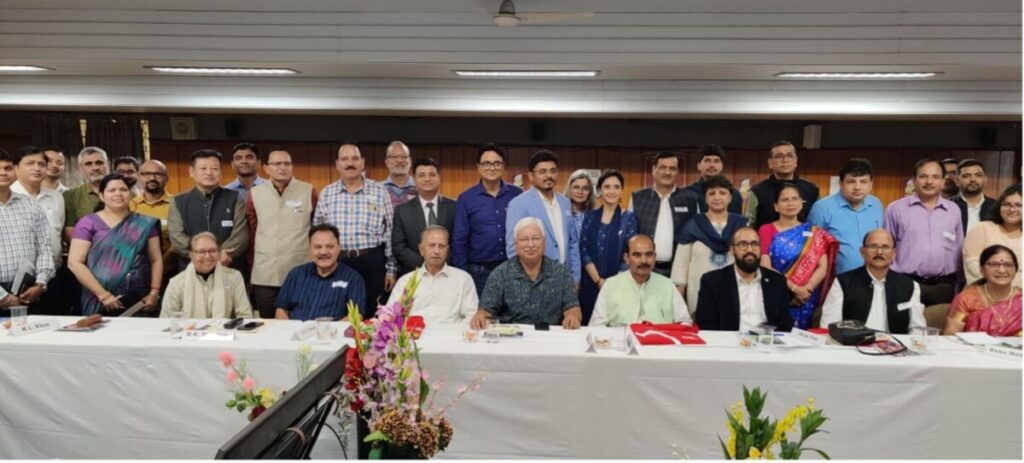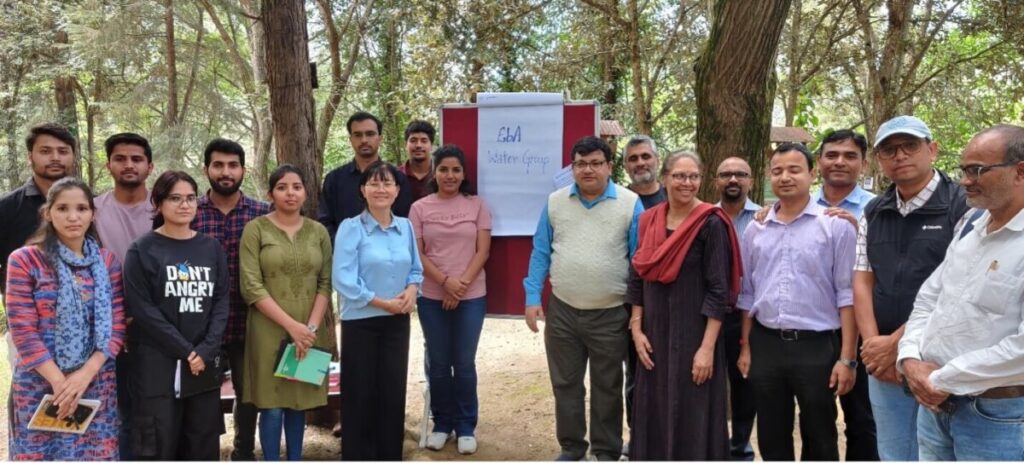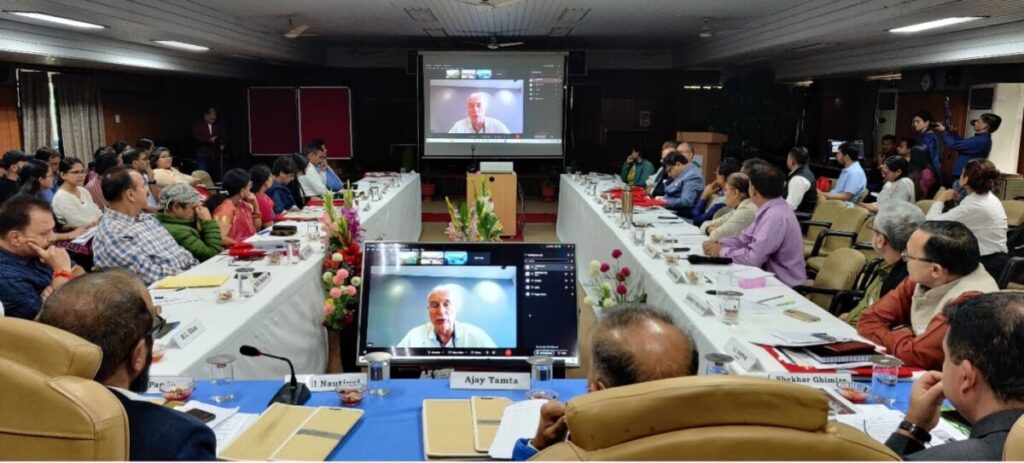Climate change has profoundly affected global ecosystems – both terrestrial and aquatic – and also the highly vulnerable indigenous people, resulting in economic and livelihood losses, biodiversity depletion, and shifts in cultural practices. It is in such a grim scenario that the significance of nature-based solutions (NbS), or ecosystem-based adaptation (EbA), comes into play. Such solutions offer ways to mitigate risks to ecosystems and people, as highlighted in the IPCC AR6 Technical Report [1].
Recently, in September 2023, in a bid to explore the various dimensions of EbA (the Indian government officially uses the term EbA instead of NbA), a multi-stakeholder meeting [2] was held in Almora, India, under the auspices of the Himalayan Resilience Enabling Action Programme (HI-REAP), supported by the UK’s Foreign Commonwealth and Development Office (FCDO). The event was organised by the International Centre for Integrated Mountain Development (ICIMOD), the G.B. Pant National Institute of Himalayan Environment (NIHE), and the Indian Ministry of Environment, Forest, and Climate Change (MoEF&CC).
The event’s objective was to facilitate a shared understanding and rethink around EbA practices in the areas of water, livelihoods, and disaster risk reduction (DRR). It brought together experts and stakeholders engaged in the spheres of sustainable land and water resource management, ecosystem services management, climate change adaptation, and sustainable livelihoods.
Above all, what was underscored at the meeting was the need for institutions to collaborate in a consultative process tailored to meet the unique challenges of the Indian Himalayan Region (IHR).
 [3]
[3]Unlocking sustainable water management
In the IHR, the age-old challenge of water management has taken on a new dimension as climate change and human activities have been taking a toll on its delicate ecosystems. A recent study on EbA to address the grave issue of water insecurities in the IHR revealed a dual focus on traditional practices and modern interventions.
At the multi-stakeholder Almora gathering, the experts called for a departure from conventional strategies to tackle the water crisis. They advocated for harnessing the knowledge embedded in traditional water collection methods and for the preservation of natural springs, which, in fact, are drying up rather rapidly in the IHR [4].
As regards general EbA measures, the specialists pointed to the efficient use of raw materials and the need for overall waste reduction. They also stated that the involvement of women and the indigenous communities are vital for the success of EbA initiatives. In the Indian context, it was pointed out that despite the absence of a national-level decision-making process for EbA, some measures like the MoEF&CC’s Green Skill Development Programme (GSDP) and the Mahatma Gandhi National Rural Employment Guarantee Act (MGNREGA) did embody EbA principles.
Traditional and modern EbA solutions
The mountains of the Himalaya serve not just as a picturesque backdrop but also as a cradle for livelihoods deeply intertwined with the ecosystem. At the meeting, the experts, while dwelling on the pursuit of sustainable practices, focused on the coexistence of traditional and modern solutions. Traditional agricultural practices, deeply rooted in the understanding of local ecosystems, were recognised as quintessentially EbA, while the cultivation of indigenous crops, adoption of agroforestry techniques, and the incorporation of traditional knowledge were cited as vital components of successful EbA for livelihoods. As for the indicators of EbA success, the stakeholders listed raw material efficiency, waste reduction, climate adaptation, preservation and restoration of ecosystems, and sound market linkages. It was also pointed out that while explicit EbA-focused policies were lacking at national, state, and district levels in the IHR, their integration into existing programmes indicated a promising pathway.
 [5]
[5]EbA in disaster risk reduction: A cultural lens
In the face of escalating climate-induced disasters, the discussions delved into the role of EbA in disaster risk reduction. Drawing insights from traditional and culture-based solutions, deeply rooted in local practices, the discussions highlighted the efficacy of resilient infrastructure, primitive construction practices, and community-based forest protected areas (PAs). The emphasis was also on a proactive approach to DRR, with the need for measures that transcended reactive responses. Besides, the experts urged for a holistic consideration of ecological factors in DRR strategies in alignment with the principles of EbA.
Conversations were also held around the importance of incorporating ecological aspects into springshed management; the threats to critical water sources were identified as mining, blasting, and earthquakes.
 [6]
[6]EbA requires institutional innovation
A critical session of the meet was a technical discussion on institutional innovation for cross-sectoral coordination. The session highlighted the need for a comprehensive approach to policy pathways, institutional capacities, and financial mobilisation for scaling springshed management. The key outcomes that emerged included proposals for the integration of springshed management into national policies, the establishment of a nodal agency for springs at the state level, formulation of clear springshed management guidelines, and giving due recognition for indigenous knowledge in springshed development programmes. The experts also lay stress on education, capacity building, and the implementation aspect in developing institutional capacities for springshed management. As regards the finances, the call was for financial pathways centred on synergies with funding agencies, government programmes, international sources, the private sector, and local communities; the avenue of crowdfunding too was mooted.
Looking ahead
The rethinking of EbA strategies for the IHR is a dynamic process, one which has to blend traditional wisdom with modern interventions, ecological preservation with sustainable livelihood practices, and proactive disaster risk reduction with gender and socially inclusive institutional innovation. It also calls for a better integration of scientific information and proven solutions (list below) to scale up EbA initiatives. At Almora, the collective efforts of the diverse stakeholders in this picturesque yet fragile region signalled a promising step towards a harmonious and resilient future.
A few EbA solutions:
- Integrated watershed management
- Springshed management
- Wetland conservation
- Organic farming
- Sustainable agricultural practices
- De-concretisation of lakes and ponds
- Community-based forest management
- Maintenance of sacred groves
- Bioengineering for slope stabilisation and gully control
- Agroforestry, including beekeeping
- Cultivation of traditional crops (like millets and kidney beans)
- Waste to wealth